The Artist
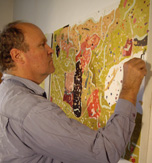
James Yuncken has been exhibiting regularly in Melbourne for around 25 years (at fortyfivedownstairs since 2008). He began studying privately in Canberra in 1986 under Christopher Croft of the Graphic Investigation Dept, Canberra School of Art. Later he undertook master classes with Graham Nickson of the New York Studio School in 1998 and 2004.
Prior to painting James completed Degrees in Science, Law and Computing.
James lives and works in Melbourne.
For a more detailed exhibition, work and educational history see: Artist CV
Process, Creativity and the Work
The Artistic Well-spring, 1990 - 2014
Overview
Process plays an important role in shaping my work. It's not just a set of procedures and tools I use to make an artwork. It's the means by which I tap into the artistic well-spring, creativity.
A process develops over time. First you decide on an approach. Over time you refine it to make it work better for you, or evolve it to tackle new problems. Or if circumstances change you may abandon it and try something altogether different.
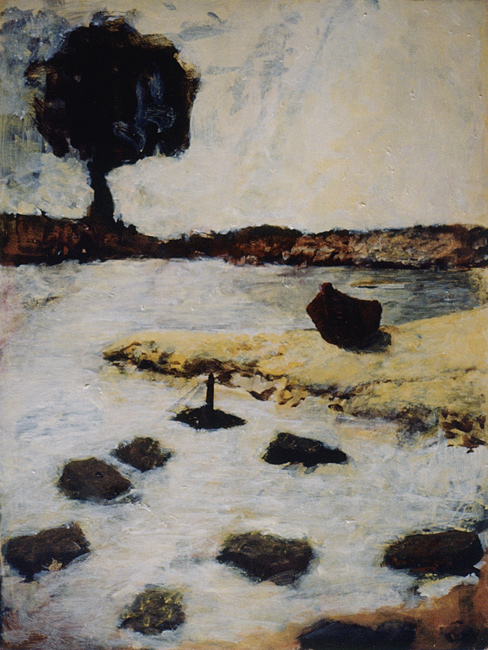 At first I adopted an approach I call The Waking Dream. It's purely an interaction between
the artist and the canvas. I used this approach between 1990 and 2009
At first I adopted an approach I call The Waking Dream. It's purely an interaction between
the artist and the canvas. I used this approach between 1990 and 2009
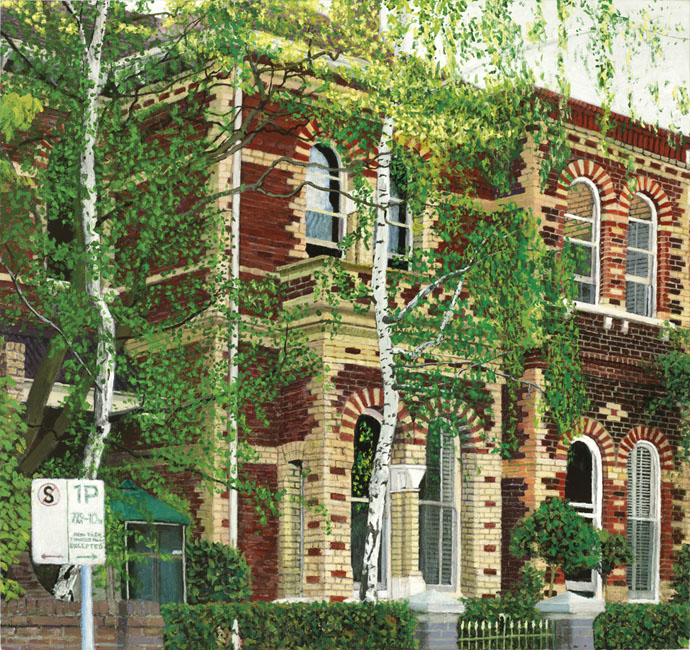 From 2009 I changed my approach to what I call Hyperrealism. The artwork is photo based.
The content of the photograph is retained unchanged, but rendered so as to heighten its effect
on the senses of a viewer. I want them to not just see the place but feel it and be there.
From 2009 I changed my approach to what I call Hyperrealism. The artwork is photo based.
The content of the photograph is retained unchanged, but rendered so as to heighten its effect
on the senses of a viewer. I want them to not just see the place but feel it and be there.
These two processes and their relationship to the work they helped produce are described in more detail below.
1. The Waking Dream
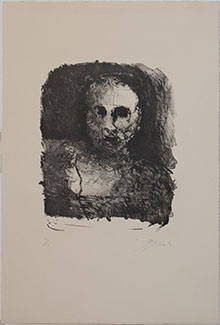

What fascinated me starting out as an artist was the visual world that our minds could unlock. Dreaming evidenced a powerful capacity to create visions. The interesting thing was that innate visual capacity. Could that be tapped?
The key elements of The Waking Dream, worked out over time, were:
- No preconceived image or idea
- Start by making arbitrary, spontaneous marks
- Make more marks that spontaneously respond to the existing ones
- All the while engage your imagination: do the marks suggest anything?
- Keep going until you start to see something, a suggestion...
- Follow the suggestion, BUT always be prepared to abandon it if it gets bogged down, stuck or unworkable for some reason. (If you have to abandon, the easiest way is to obliterate it and start again from square one, i.e. more marks.)
After a time I usually found a suggestion that could be followed to a conclusion.
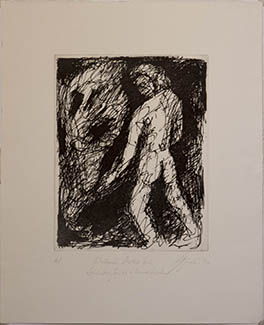
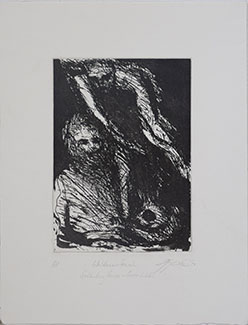
These two early works illustrate how images emerged from a welter of marks. They were done in response to a particular piece of music, Schoenberg's Gurre-Lieder. Later on I ceased to listen to music when working because of its influence on the outcome.

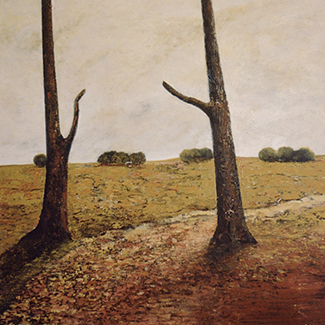
The rawness and energy of these works was exciting but I worried that they were somehow crude and awkward. Anatomical correctness and other constraints of external realities do not always matter in inner worlds and inner realities. In an artwork adherence to an internal logic that the work itself sets up is the more important and persuasive thing. But the external world continually crops up in the work, so how to handle the intersection of these two worlds was always an issue.
In Sense of Place, an exhibition of landscapes in 2003, what turned up at the intersection of these two worlds was memory, or perhaps, experience.

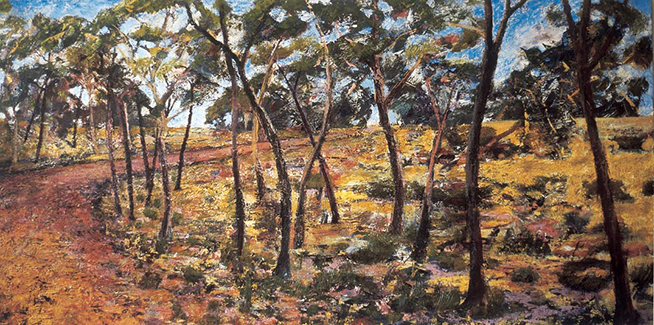
I had been determined to make these fictional landscapes look 'real'. And people did think that they looked real. Many even thought they looked familiar. They were reminded of places they knew, although for each person a different place. An agricultural scientist familiar with a very wide variety of Australian landscapes observed that he could show me this landscape in virtually any State or Territory in the country.
The feel of 'reality' in Sense of Place was achieved indirectly, via recognition. I have a much greater ability to recognise what looks right - or not - than I do to actually remember and reproduce detail. By experimenting with and manipulating colours, textures, etc, I could arrive at something that looked and felt right.
It felt like painting abstractly to produce something that looked 'real'. I realised that, in fact, most of The Waking Dream approach was formal and abstract.
Sense of Place had been pivotal. It led me to insights about how the accumulation of memory and experience might work, about the importance of recognition and the relative feebleness of recall.
It also brought home the centrality in all art of the formal and abstract aspects of a painting: Composition, relationships between parts and the whole, the use of shape, colour and texture, etc, weighing and balancing things to achieve or heighten some or other effect. Pretty much all that shapes the mood, poetry or subtext in the scene and determines how you experience it.

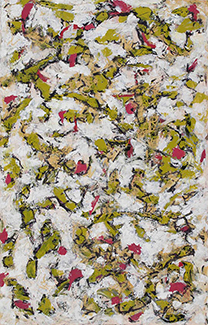
So I set out to explore what The Waking Dream would produce if the search for a suggestion of 'something' were abandoned and it became purely a game of Formal Considerations.
After Formal Considerations, 2005 came Abstraction and Space, 2008.
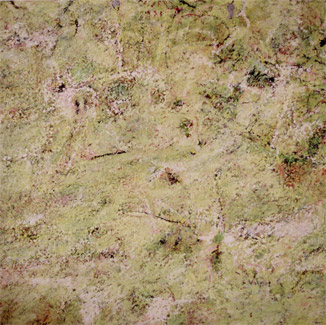
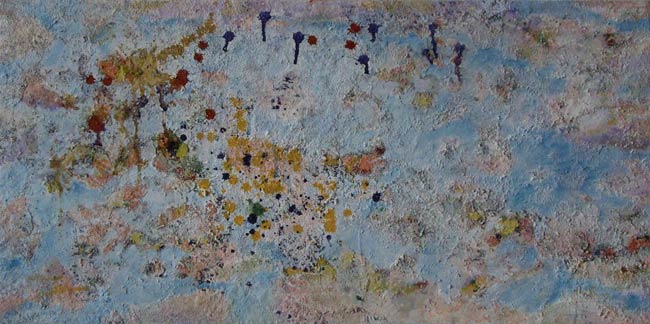
After Abstraction and Space in 2008 events took a different turn.
2. Hyperrealism: Transition to photographically based work
In 2009 I was invited to participate in a trip to the very top of Australia, Cape York. It was a four wheel driving expedition which took us through some very challenging and beautiful terrain. I had planned to sketch along the way, but the constraints of the journey did not allow much time for that. Instead I became the trip's photographer.
I returned home after the trip with an exhibition looming. The Waking Dream is a slow process and I realised there was no way it would get me to the 2010 finish line. With great trepidation I reached for the photographs.
Painting from photographs is full of pitfalls. What's the point, for starters? Great photography (that's not mine!) has no need of being translated into paint.
Photography can also make a painter lazy. It can be a way of opting out of the creative act central to all art. It can become an exercise in mindless copying without really questioning or understanding what you are looking at (thereby getting things wrong). I had certainly seen plenty of work that I felt owed its mediocrity to the use of photography.
So there are a few challenges. My solution was to try to create paintings that would put an observer, in as far as possible, in that place, as I had been; that they could feel the earth and the atmosphere through their eyes.
My dictionary equates hyperrealism with photorealism. But the photorealism I am familiar with often reproduces the rather flat, undifferentiated nature of photographs. Everything the camera sees tends to be treated equally, the same (maybe not in the hands of skilful and creative photographers, but for most of us).
What I mean by hyperrealism is an attempt to enhance the content of the photograph with an appeal, through the eyes, to the senses. Inevitably there is also differentiation between parts of the content.
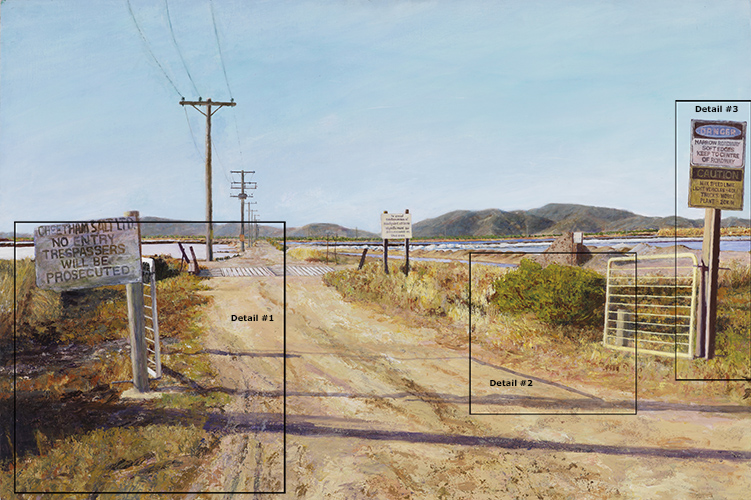
The way to capture the detail - sometimes detail which was beyond the photograph's level of resolution - was again to improvise using colour, texture and shapes that mimicked the sense of the detail, as in Sense of Place, to create the illusion of detail and of precision.
The same applied in Walking to Work and Places Nearby, exhibitions of urban landscape. For these I had the added luxury of being able to revisit the scenes to check the details that were unintelligible from looking at the photograph.
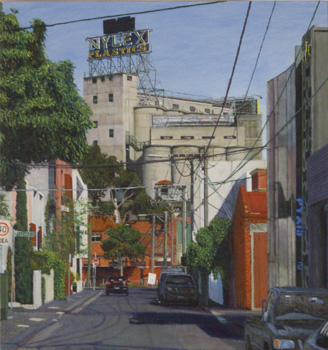
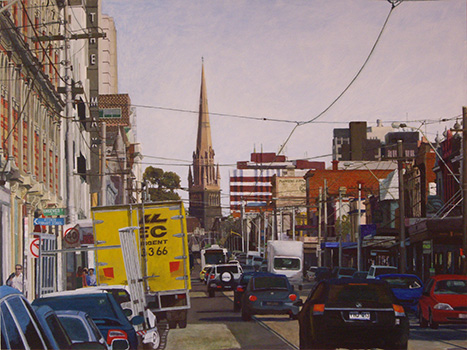
James Yuncken, August 2015